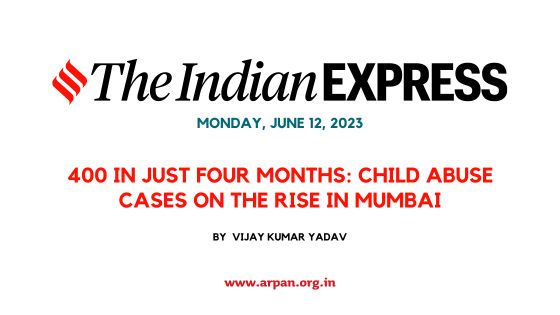India shelters 430 million children, approximately one in five children (individuals under age 18) in the world and the government assesses that 40 % of India’s children are susceptible to intimidations such as trafficking, homelessness, forced labour, drug abuse, and crime. Every 2nd child is being exposed to one or the other form of sexual abuse and every 5th child faces critical forms of it. They all are in need of protection.
In 2006, a study on CSA was conducted on 2211 class XI students, girls and boys, who had different socioeconomic upbringing and attended mainstream schools by the Chennai-based NGO Tulir – Centre for Prevention and Healing of Child Sexual Abuse, and international organisation Save the Children. The results showed that 939 (42%) out of 2211 children had faced at least one form of sexual abuse at some point in time. 39 per cent of the girls faced sexual abuse, compared to 48 per cent of the boys.
Another significant study at the pan Indian level has been the National Study on Child Abuse (2007). This study, which is the largest of its kind, covered 13 states with a sample size of 12447 children, 2324 young adults and 2449 stakeholders.
The National Study reported the following:
53.18 % children in the family environment not going to school reported facing sexual abuse.
49.92% children in schools reported facing sexual abuse.
61.61% children at work (Shop, factory or other places) reported facing sexual abuse.
54.51% children on the streets reported facing sexual abuse.
47.08 % children in institutional care reported facing sexual abuse.
20.90% of all children were subjected to severe forms of sexual abuse that included sexual assault, making the child fondle private parts, making the child exhibit private body parts and being photographed in the nude.
50% abusers are persons known to the child or in a position of trust and responsibility.
Reasons for the prevalence of CSA in India
In Indian context, Child Sexual Abuse (CSA) is snowed under many different suppositions and oppositions. Some assumptions are:
Out of sheer curiosity children must have asked for sexual contact.
Sexual abuse is part of the process of growing up and does not lead to any negative consequences.
Very young children cannot be abused sexually.
Boys cannot be abused, only poor are abused.
Women being the caregivers can never be offenders etc.
The reality contradicts these assumptions. Nonetheless, after trying to make people constantly aware of these facts, the myths prevail.
Adults of our society are interpellated with many unacceptable stereotypical messages and the same is passed to future generations. Child sexual abuse in India thrives on this very mentality. Parents have no idea how adversely this crime can affect children in their adulthood.
Break the silence
Despite the harsh statistics, currently there are only four organizations in India working on the issue in a determined manner. Hence, the need is great to make people aware about this issue and talk more about it openly. Getting involved in the fight against sexual abuse is the only way to prevent it. We should raise awareness of the prevalence and consequences of child sexual abuse by educating adults about preventive steps, recognize and react responsibly to the reality of child sexual abuse. We need to teach children, both boys and girls about empathy, respect, compassion and consent.
Read more about how to recognise and prevent child sexual abuse.
At Arpan, we do all these things and more, through our Personal Safety Education programme for Schools, communities, and institutions and run awareness and training programmes for adults and caregivers from different walks of life. However, the true power to end Child Sexual Abuse rests in the hands of the common man, people like you and me, who can stand up and break the silence around this heinous crime. Together we can achieve any goal.
Source: Jaagore











